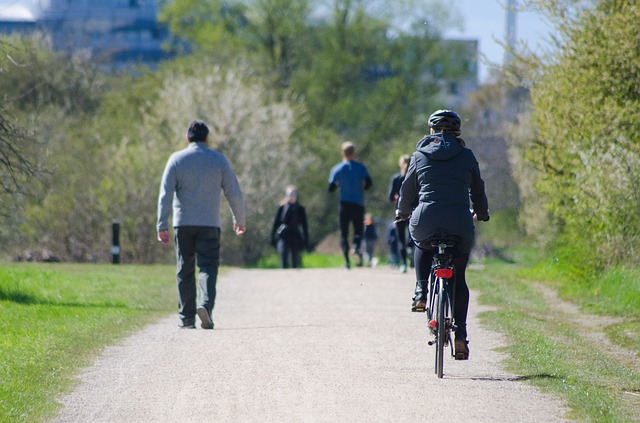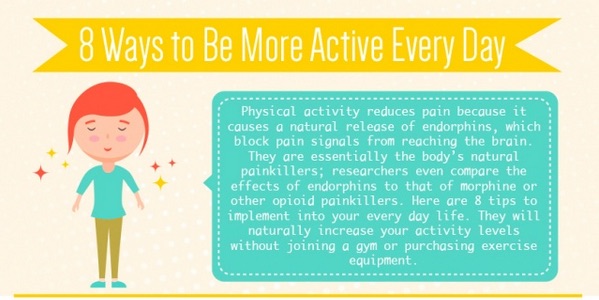 When we are pain we seem to do all that is in our power to avoid making it worse, right? For some people this may mean limiting most of their activity altogether. Unfortunately, ignoring pain does not make it go away nor does avoiding motions that may cause discomfort. This avoidance, in fact, creates greater problems including weakened muscles, compromised posture, and further joint trouble. However, studies have discovered that regular physical activity aids in the reduction of chronic pain.
When we are pain we seem to do all that is in our power to avoid making it worse, right? For some people this may mean limiting most of their activity altogether. Unfortunately, ignoring pain does not make it go away nor does avoiding motions that may cause discomfort. This avoidance, in fact, creates greater problems including weakened muscles, compromised posture, and further joint trouble. However, studies have discovered that regular physical activity aids in the reduction of chronic pain.
Everyone responds to pain differently, but research has been able to harness a quantitative measure to compare levels of pain. Our pain threshold refers to when we begin to feel pain and our pain tolerance is the amount of time we can handle pain before stopping whatever we are doing that is causing it. The vice president with Champion Sports Medicine in Birmingham Alabama, Trent Nessler, PT, DPT, MPT, explains, “Exercise improves your pain threshold. With chronic pain, your pain threshold drops -- in other words, it takes less pain to make you feel more uncomfortable. With cardiovascular, strengthening, and flexibility exercise, you can improve that pain threshold.”
Researchers at the University of New South Wales and Neuroscience Research Australia studied exactly that. They measured the pain thresholds by using a device that applies pressure to one’s arm. When the pressure graduated from unpleasant to painful, volunteers were urged to say, “stop.” Pain tolerance was measured using an increasingly tight blood pressure cuff and a handheld squeezable device. The volunteers were encouraged to continue squeezing the device for as long as they could to determine their standard pain tolerance. After collecting the beginning data, one group began stationary bicycling for 30 minutes a day, three times a week for a total of six weeks. The other group did not change their activity level at all. After the 6 weeks of observation, volunteers who were involved with the new exercise routine showed substantial improvements in their ability to handle pain. While their pain thresholds did not change, their tolerance had noticeably increased. Whereas, the group of volunteers who did not participate in the fitness routine didn’t show any changes in their response to pain.
Professionals encourage those dealing with pain to find activity that works for them and to know what their body can and can’t handle. There is no need to force yourself to go to the gym and lift weights if you can’t physically do it, but there are different types of physical activitity that your body might be able to handle better.
Exercise may not cure pain altogether but we now know that it can distract your mind from it and train your brain to better handle the pain. As Trent Nessler said, “With chronic pain comes a reduced quality of life. Exercise can dramatically improve that quality of life again.”
Here are some ways to get moving, even with aches and pains:
-Start small: Begin with simple exercises that just get you moving. Do not feel like you have to be doing it all to reap the benefits of exercise.
-Be in contact with a professional: It is invaluable to have a routine that caters to your needs and a professional can help you with this. You may notice a peace of mind because you know that you are moving in ways that will benefit you rather than aggravate existing issues.
-Apply a topical pain relief lotion before your designated activity: Topical lotions can help reduce pain and stiffness so that you can find some relief before heading out to be active.
-Make it fun: Although you may experience some pain at first, exercising does not have to be a negative experience. Find activities that get you moving in ways you enjoy, like dancing, bowling, walking, golfing, kayaking, bicycling, and so many more! Bring a friend who will encourage you and ensure that you enjoy your environment!
Related: How to Start Exercising When You Are In Pain, 7 Ways to Be More Active Every Day
Check out our articles and infographics to learn a multitude of ways to start relieving your pain naturally!
At Real Time Pain Relief, we not only care about the quality ingredients that go into each and every one of our products – but also about the people who buy them. We hope this blog, and the articles posted on it, become a valued resource for your own personal journey to better health. We know natural products that reduce your pain at the source are important to you, and for more than 17 years, our Real Time Pain Relief rub-on has been providing fast acting, targeted pain relief with natural ingredients to thousands of satisfied customers. From the useful information on this blog to our high-quality natural products, we hope you become one of the thousands of customers telling us they “Enjoy Living Again!”
Sources:
- https://well.blogs.nytimes.com/2014/08/13/how-exercise-helps-us-tolerate-pain/?_r=1
- https://www.ncbi.nlm.nih.gov/pubmed/24504426
- http://www.health.harvard.edu/healthbeat/the-secret-to-joint-pain-relief-exercise
- http://www.prevention.com/health/health-concerns/how-exercise-chronic-pain
- http://www.webmd.com/pain-management/features/exercise-relief
- Log in to post comments


